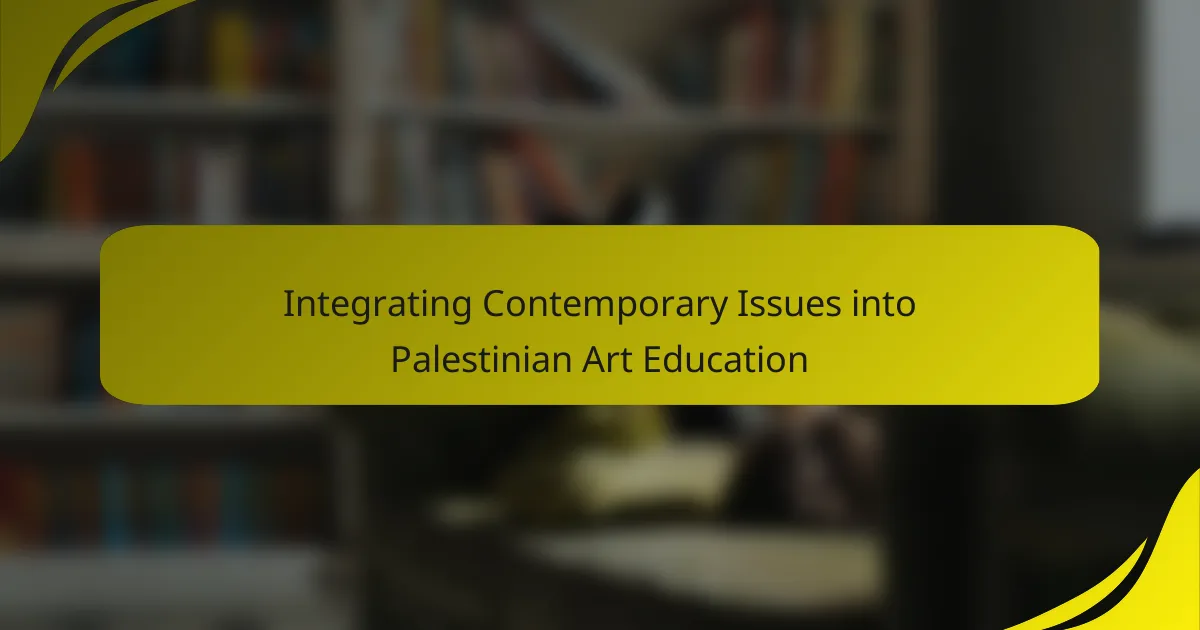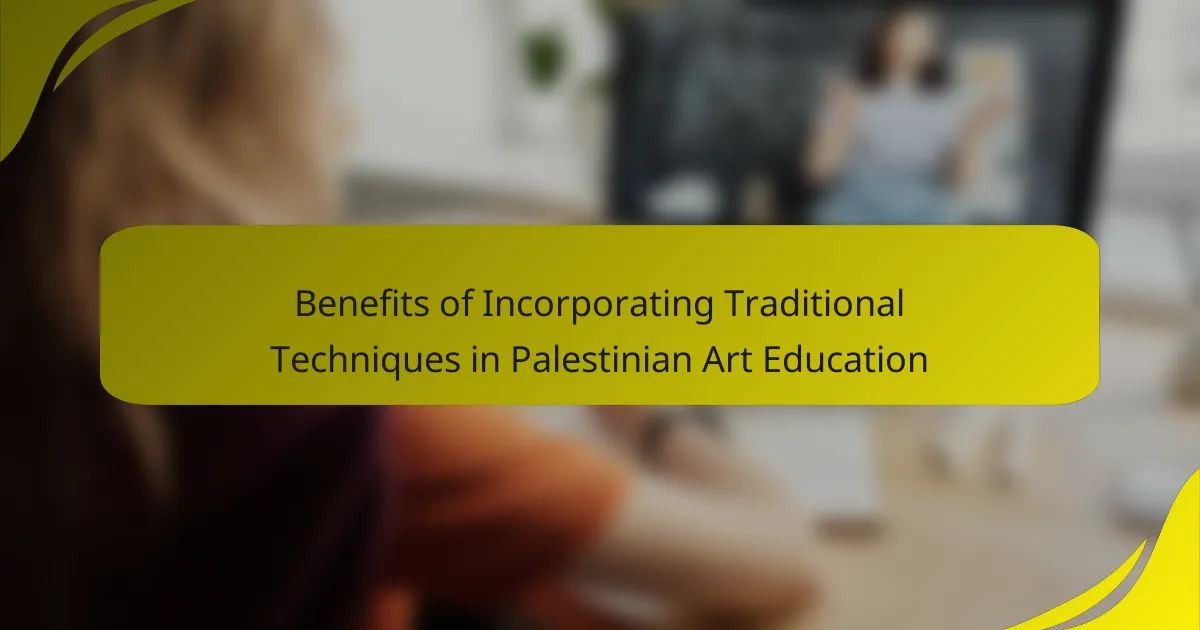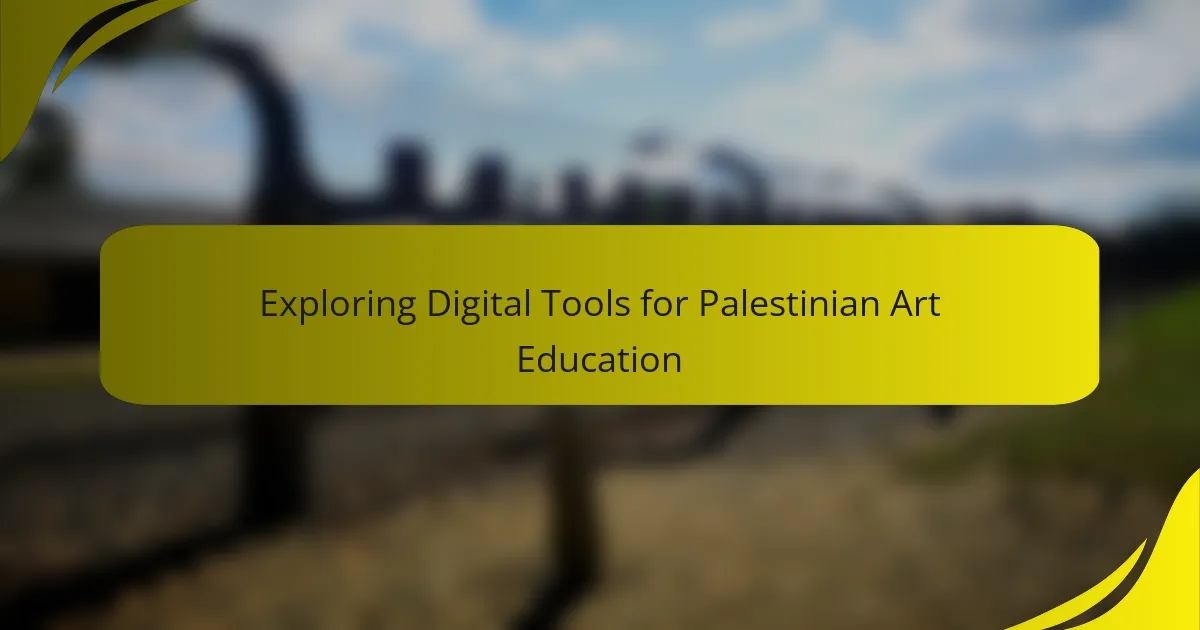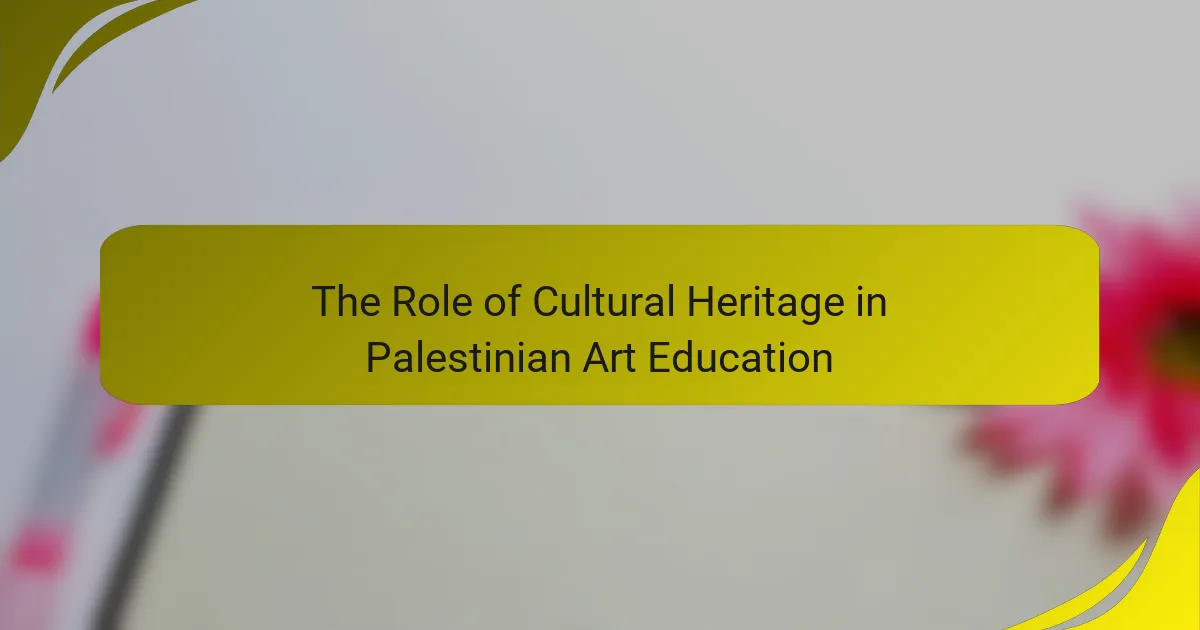Collaboration is a central theme in Palestinian art education, emphasizing community engagement and collective creativity among artists and educators. This approach enhances the learning experience by allowing for resource sharing and diverse artistic expression, while also addressing social and political issues relevant to Palestinian society. Despite facing challenges such as political instability, limited resources, and cultural barriers, successful collaborative efforts lead to increased creativity, innovation, and stronger community ties. Ultimately, collaboration enriches the art education framework in Palestine, fostering a more inclusive and impactful environment for students.
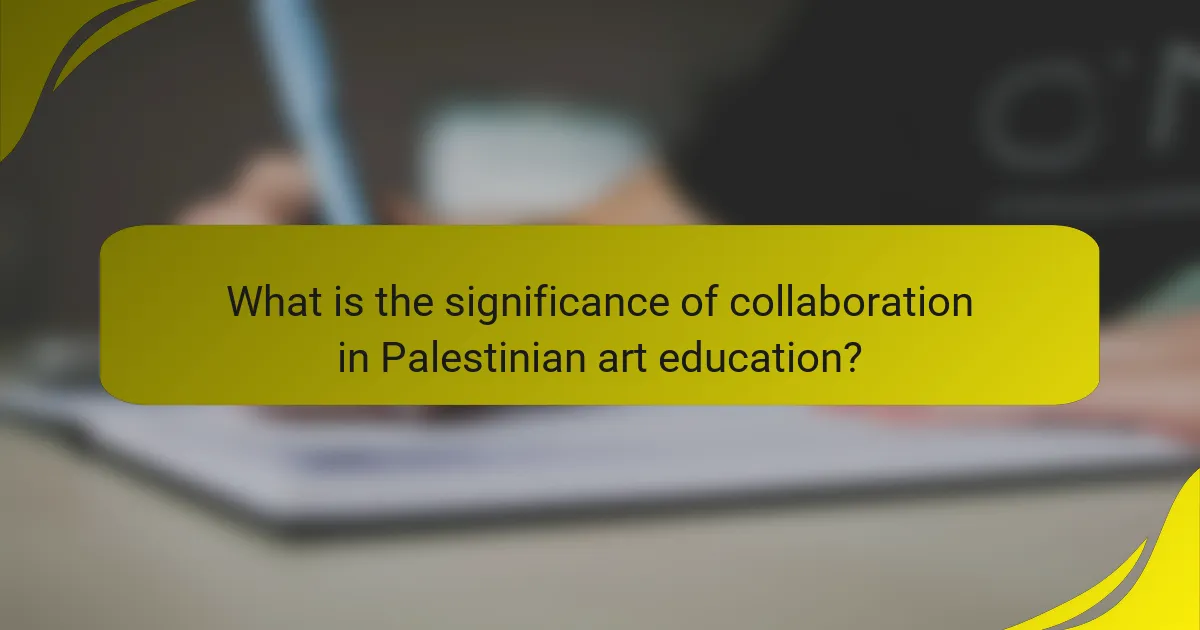
What is the significance of collaboration in Palestinian art education?
Collaboration is significant in Palestinian art education as it fosters community engagement and collective creativity. It allows artists and educators to share resources and knowledge. This collaborative approach enhances the learning experience for students. It also encourages diverse perspectives in artistic expression. Collaborative projects can address social and political issues relevant to Palestinian society. By working together, artists can amplify their voices and reach broader audiences. This method promotes cultural exchange and solidarity among artists. Ultimately, collaboration strengthens the art education framework in Palestine, making it more inclusive and impactful.
How does collaboration enhance the learning experience in Palestinian art education?
Collaboration enhances the learning experience in Palestinian art education by fostering creativity and cultural exchange. It encourages students to share diverse perspectives and techniques. This interaction leads to richer artistic expression and innovation. Collaborative projects often involve community engagement, connecting students with local artists. Such connections provide mentorship opportunities and real-world insights. Research indicates that collaborative learning improves critical thinking and problem-solving skills. Additionally, it helps build a supportive learning environment, promoting emotional well-being among students. Overall, collaboration plays a crucial role in developing artistic skills and cultural awareness in Palestinian art education.
What are the key elements of effective collaboration in art education?
Effective collaboration in art education involves communication, mutual respect, shared goals, and diverse perspectives. Communication ensures all participants express their ideas clearly. Mutual respect fosters a positive environment for creativity. Shared goals align the efforts of all collaborators towards a common outcome. Diverse perspectives enrich the creative process and lead to innovative solutions. Research indicates that these elements enhance student engagement and learning outcomes in art education settings.
How do collaborative projects influence student creativity and expression?
Collaborative projects enhance student creativity and expression by fostering a shared environment for idea exchange. Students engage with diverse perspectives, which stimulates innovative thinking. Working together encourages risk-taking, as students feel supported by peers. This collaborative atmosphere promotes experimentation with different artistic techniques. Research shows that collaboration leads to higher levels of creativity compared to solo projects. A study by the University of Michigan found that group work significantly boosts creative output in educational settings. Thus, collaborative projects are vital in enhancing student creativity and expression in art education.
Why is collaboration essential for cultural preservation in Palestinian art?
Collaboration is essential for cultural preservation in Palestinian art because it fosters a collective approach to safeguarding heritage. Through collaboration, artists can share techniques and narratives that reflect their cultural identity. This exchange strengthens the community’s connection to their history and traditions. Collaborative projects often result in diverse artistic expressions that represent various perspectives within Palestinian culture. For instance, initiatives like the “Palestinian Art Academy” promote joint exhibitions and workshops. These efforts not only enhance visibility but also create a platform for dialogue among artists. Furthermore, collaboration helps to document and archive artistic practices that might otherwise be lost. The combined efforts of artists, educators, and cultural organizations ensure that Palestinian art remains vibrant and relevant in the face of challenges.
How does collaboration help in sharing traditional art forms?
Collaboration enhances the sharing of traditional art forms by fostering diverse perspectives and skills. It brings together artists, educators, and communities to create a richer cultural dialogue. This exchange helps preserve and innovate traditional techniques. Collaborative projects often attract wider audiences, increasing visibility for these art forms. For example, joint exhibitions can showcase multiple artists’ works, highlighting shared heritage. Research indicates that collaborative efforts in art education lead to greater community engagement and appreciation. This engagement can result in workshops that teach traditional practices to new generations. Ultimately, collaboration strengthens the transmission of cultural knowledge and artistic expression.
What role does collaboration play in fostering community engagement through art?
Collaboration plays a critical role in fostering community engagement through art. It facilitates shared creative processes among artists, educators, and community members. This interaction enhances the relevance of art to local issues and cultures. Collaborative projects often lead to greater participation from diverse groups. They create a sense of ownership and belonging within the community. For instance, community art initiatives can address social concerns and reflect collective identities. Studies show that collaborative art projects increase community cohesion and awareness. Engagement in these projects often results in lasting relationships and networks among participants.
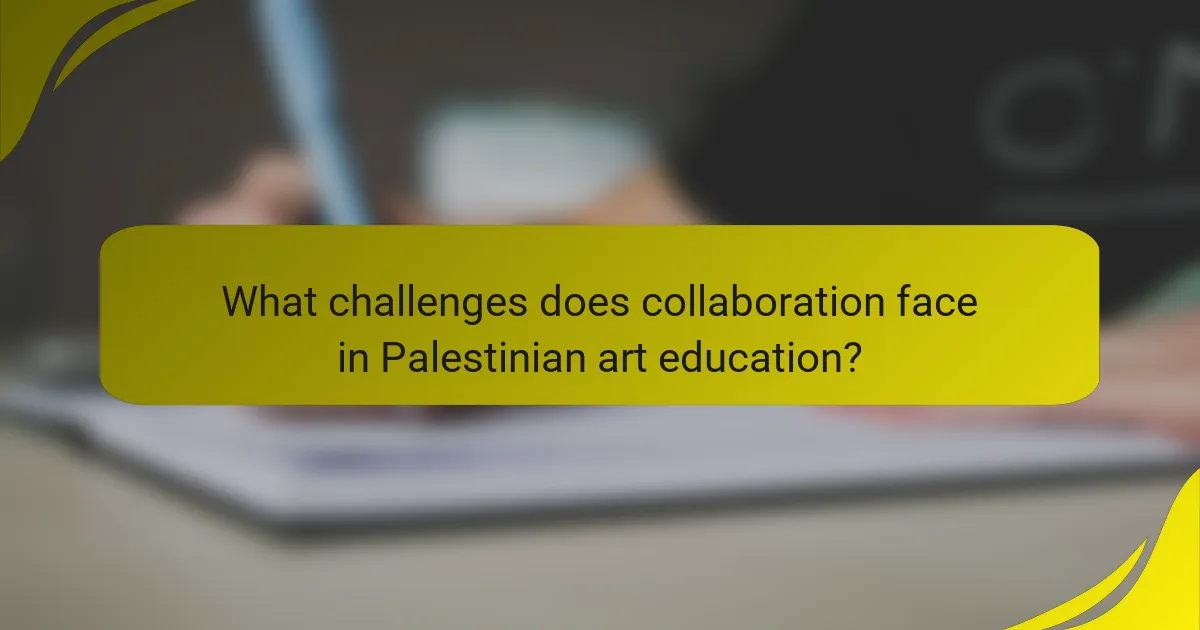
What challenges does collaboration face in Palestinian art education?
Collaboration in Palestinian art education faces several significant challenges. Political instability often disrupts educational initiatives and collaboration efforts. Limited resources hinder access to materials and facilities necessary for effective artistic expression. Cultural barriers can create misunderstandings between different groups involved in art education. Additionally, varying educational backgrounds among participants can lead to disparities in skill levels. Restrictions on movement within the region further complicate collaborative projects. Lastly, a lack of institutional support can impede the development of sustainable collaborative frameworks. These challenges collectively undermine the potential for enriching art education through collaboration.
How do political and social contexts impact collaborative efforts?
Political and social contexts significantly impact collaborative efforts by shaping the environment in which individuals and groups operate. In regions with political instability, such as Palestine, collaboration may be hindered by restrictions on movement and communication. Social contexts, including cultural norms and values, influence how communities engage with one another. For instance, in Palestinian art education, collaboration can be affected by the ongoing conflict, which creates a need for solidarity among artists and educators.
Research indicates that collaborative efforts thrive in environments that promote trust and shared goals. A study by the Institute for Palestine Studies highlights how collaboration in art education fosters resilience and cultural expression amidst adversity. Therefore, understanding the political and social landscape is crucial for effective collaboration in Palestinian art education.
What barriers do educators encounter in facilitating collaboration?
Educators encounter several barriers in facilitating collaboration. Limited resources hinder joint projects and initiatives. Time constraints often prevent effective collaboration among educators. Lack of administrative support can diminish motivation to collaborate. Differences in teaching philosophies may create conflicts among educators. Cultural and language barriers can impede communication and understanding. Additionally, inadequate training on collaborative practices limits educators’ ability to work together effectively. These barriers collectively impact the quality of collaboration in Palestinian art education.
How can these challenges be addressed to improve collaboration?
Establishing open communication channels can address challenges to improve collaboration. Regular meetings can foster dialogue among educators and artists. Utilizing digital platforms can enhance accessibility and engagement. Training sessions can equip participants with collaboration skills. Setting clear goals can align efforts and expectations. Encouraging feedback can create a culture of continuous improvement. Collaborative projects can provide practical experience and strengthen relationships. Evidence shows that structured collaboration leads to enhanced creativity and innovation in educational settings.
What strategies can be employed to promote collaboration in Palestinian art education?
Promoting collaboration in Palestinian art education can be achieved through various strategies. Establishing partnerships between educational institutions and local art organizations is essential. These partnerships can facilitate resource sharing and joint projects. Encouraging interdisciplinary approaches can also enhance collaboration among different fields of study. Workshops and collaborative art projects can foster teamwork among students and educators. Additionally, leveraging digital platforms can connect artists and educators beyond geographical limitations. Hosting community art events can engage the public and promote collective creativity. Research indicates that collaborative learning improves student engagement and creativity, making these strategies effective.
What types of partnerships are most effective for fostering collaboration?
Strategic partnerships are the most effective for fostering collaboration. These partnerships can include collaborations between educational institutions, local artists, and community organizations. Strategic partnerships create shared goals and resources. They encourage knowledge exchange and skill development. Research indicates that collaborative projects enhance creativity and innovation. For example, partnerships between universities and local art collectives often result in impactful community art projects. Such collaborations can also provide funding and support for initiatives. They help to bridge cultural gaps and promote inclusivity in art education. Effective partnerships leverage diverse perspectives to enrich the learning experience.
How can technology be utilized to enhance collaborative art projects?
Technology can enhance collaborative art projects by facilitating communication and sharing of ideas. Digital platforms allow artists to connect in real-time, regardless of location. Tools like video conferencing enable discussions and brainstorming sessions. Collaborative software, such as Google Docs or Trello, helps organize project tasks and timelines. Social media platforms allow for broader audience engagement and feedback. Virtual reality can create immersive environments for collaborative experiences. Online galleries can showcase collective works, increasing visibility. Research shows that technology fosters creativity and innovation in group settings.
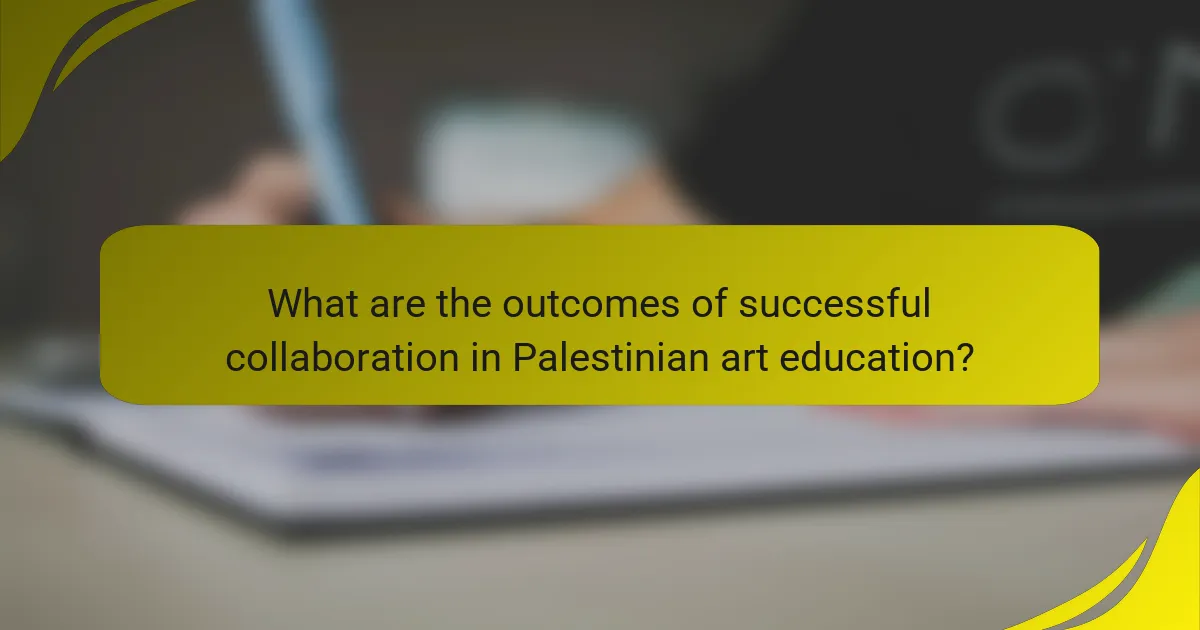
What are the outcomes of successful collaboration in Palestinian art education?
Successful collaboration in Palestinian art education leads to enhanced creativity and innovation among students. It fosters a supportive learning environment that encourages artistic expression. Collaborative projects often result in diverse artistic outputs reflecting a variety of cultural perspectives. Increased access to resources and expertise is another significant outcome. Students benefit from shared knowledge and skills from peers and educators. This collaboration also strengthens community ties and promotes cultural exchange. Research indicates that collaborative learning improves critical thinking and problem-solving abilities. Overall, these outcomes contribute to a more vibrant and inclusive art education landscape in Palestine.
How does collaboration impact students’ artistic skills and confidence?
Collaboration enhances students’ artistic skills and boosts their confidence. When students work together, they share diverse perspectives and techniques. This exchange fosters creativity and innovation in their artistic expression. Collaborative projects encourage peer feedback, which is crucial for skill improvement. Studies show that students engaged in collaborative art activities demonstrate higher levels of motivation. Increased motivation correlates with enhanced artistic output and exploration. Additionally, collaboration builds a sense of community among students. This supportive environment helps reduce anxiety related to artistic performance. As a result, students feel more confident in their abilities and more willing to take creative risks.
What evidence exists to support the benefits of collaborative art education?
Collaborative art education enhances creativity and social skills among participants. Research shows that students engaged in collaborative art projects exhibit improved communication abilities. A study published in the Journal of Art Education found that teamwork in art fosters problem-solving skills. Participants in group art activities reported higher levels of satisfaction and engagement. Additionally, collaborative projects can bridge cultural gaps, promoting understanding and empathy. Evidence from various educational institutions indicates that students involved in collaborative art initiatives demonstrate greater emotional intelligence. These findings highlight the significant benefits of collaborative art education in fostering holistic development.
How do collaborative projects contribute to students’ understanding of cultural identity?
Collaborative projects enhance students’ understanding of cultural identity by fostering shared experiences and dialogue. These projects encourage students to engage with diverse perspectives. Through collaboration, students learn to appreciate the complexities of cultural narratives. Interaction with peers from different backgrounds promotes empathy and awareness. Research indicates that collaborative learning environments improve cultural competence. A study by Johnson & Johnson (2014) highlights that teamwork in educational settings leads to greater cultural understanding. By working together, students explore their own identities while respecting others’. This process deepens their connection to cultural heritage and community.
What best practices can educators adopt to facilitate effective collaboration?
Educators can adopt several best practices to facilitate effective collaboration. First, they should establish clear communication channels. This ensures that all participants understand their roles and responsibilities. Regular meetings can help maintain focus and address any concerns. Additionally, setting shared goals fosters a common purpose among collaborators. Educators should encourage open dialogue to promote idea sharing. Utilizing collaborative tools, such as online platforms, can enhance teamwork. Providing professional development on collaboration techniques can empower educators. Finally, recognizing and celebrating collaborative achievements can motivate ongoing efforts. These practices contribute to a more cohesive and productive collaborative environment in education.
How can educators create an inclusive environment for collaboration?
Educators can create an inclusive environment for collaboration by fostering open communication and respect among students. They should establish clear guidelines that promote participation from all voices. Providing diverse materials and resources can help cater to different learning styles. Educators can also implement group activities that encourage teamwork and mutual support. Training in cultural competence is essential for understanding diverse backgrounds. Regular feedback sessions can help address any issues and improve collaboration. Research shows that inclusive practices enhance student engagement and learning outcomes. For example, a study by the National Education Association found that inclusive classrooms lead to higher academic performance.
What resources are available to support collaboration in art education?
Collaborative resources in art education include online platforms, workshops, and community programs. Online platforms like Google Classroom and Padlet facilitate real-time collaboration among students and educators. Workshops often provide hands-on experiences that enhance teamwork in art projects. Community programs can connect local artists with schools, fostering partnerships. Additionally, educational grants support collaborative art initiatives. Research shows that collaboration improves creativity and student engagement in art education.
The main entity of this article is collaboration in Palestinian art education. The article highlights the significance of collaboration in fostering community engagement, enhancing the learning experience, and promoting cultural preservation within Palestinian art. Key elements of effective collaboration include communication, mutual respect, and shared goals, while challenges such as political instability and limited resources are also addressed. The article discusses how collaborative projects influence student creativity, understanding of cultural identity, and the overall educational framework, emphasizing the importance of strategic partnerships and technology in facilitating these collaborative efforts.
